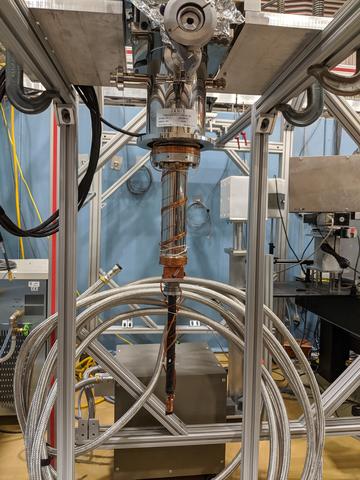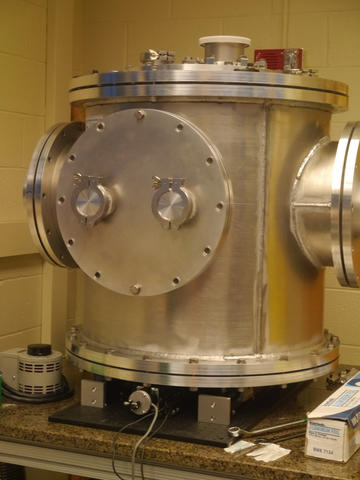Summary
The realization of Quantum 2.0 devices will require the development of new types of materials. Here we apply the techniques of neutron interferometry to study the properties of novel materials, particularly internal (non-surface) structures with chiral properties.
Description

Figure 1: The cryostat used to study quantum materials at temperatures between 10 K and 300 K. This cryostat has been modified for the specific requirements for working inside a neutron interferometer.
Neutron interferometry using perfect-silicon single crystals is a precision measurement technique that combines the neutron’s unique quantum nature with the neutron’s diverse set of interactions. Interferometry has traditionally been used in fundamental physics applications. However, there is increasing need for interferometry-based techniques for material science. For instance, a phase grating-based interferometer is being developed for the specific application of understanding material microstructure. Here, our efforts are towards the advancement of practical quantum devices/actuators. We use the established single crystal neutron interferometer combined with structured beam preparation to examine the internal structure of advanced quantum materials. A structure beam is a beam (neutron, photon, or electron) with phase information encoded into the beam itself. Of particular interest are “spin-orbit” beams where the orbital degree of freedom is coupled to the spin of the particle. Spin-orbit beams of electrons and photons have demonstrated applications in high-resolution optical imaging, high-bandwidth communication, and optical metrology.
Neutron spin-orbit neutron beams have the potential to significantly change the approach to characterizing spin-related materials and devices. Current techniques are limited to using shallow neutron reflections that measure only the surface properties of a material. By utilizing structured neutron waves, studies can be performed in a transmission configuration and thus determine the bulk characteristics of a material. In the specific case of spin-orbit states, neutron states will provide an opportunity to use neutrons as a probe of chiral and helical materials, such as skyrmions, in a way not accessible with current techniques.

Quantum materials often have phase transitions near or below room temperature. The neutron interferometry and optics facility at NIST has acquired a custom cryostat that enables the measurement of sample materials around their transition temperatures. The cryostat is shown in Figure 1. For studying quantum materials, the interferometer requires greater isolation from the environment. To this end we use a 61 cm diameter vacuum chamber (see Figure 2) to house these experiments. This vacuum chamber also allows greater temperature control of the sample when coupled to the cryostat.
Two key materials-related properties are the domain structure and the spin coherence length. A neutron interferometer can measure local domain structure and the spin coherence of less than 1 micron. We will build on our earlier experience with measuring neutron coherence and show that we can combine this with magnetic spin precession to measure the coherent cross-section via spin. This technique can be used to study topological isolators and vortex states coupled to super conductors in-situ and to perform Majorana–fermion searches. New quantum technologies will have immediate and future applications in medicine, communications, biochemistry, physics, and materials.

